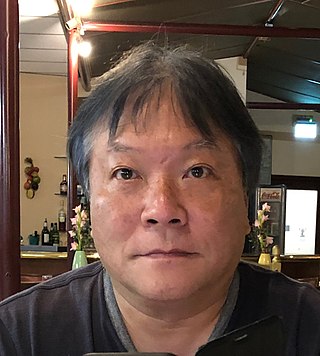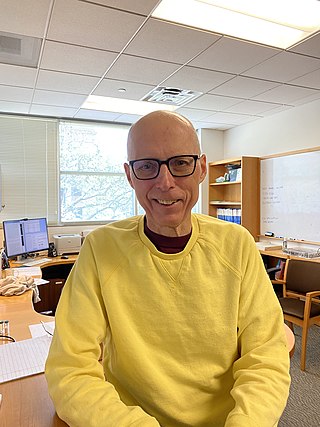
Stereochemistry, a subdiscipline of chemistry, involves the study of the relative spatial arrangement of atoms that form the structure of molecules and their manipulation. The study of stereochemistry focuses on the relationships between stereoisomers, which by definition have the same molecular formula and sequence of bonded atoms (constitution), but differ in structural formula. For this reason, it is also known as 3D chemistry—the prefix "stereo-" means "three-dimensionality".
Jean M.J. Fréchet is a French-American chemist and Professor Emeritus at the University of California, Berkeley. He is best known for his work on polymers including polymer-supported chemistry, chemically amplified photoresists, dendrimers, macroporous separation media, and polymers for therapeutics. Ranked among the top 10 chemists in 2021, he has authored nearly 900 scientific paper and 200 patents including 96 US patents. His research areas include organic synthesis and polymer chemistry applied to nanoscience and nanotechnology with emphasis on the design, fundamental understanding, synthesis, and applications of functional macromolecules.
Tobin Jay Marks is the Vladimir N. Ipatieff Professor of Catalytic Chemistry, Professor of Material Science and Engineering, Professor of Chemical and Biological Engineering, and Professor of Applied Physics at Northwestern University in Evanston, Illinois. Among the themes of his research are synthetic organo-f-element and early-transition metal organometallic chemistry, polymer chemistry, materials chemistry, homogeneous and heterogeneous catalysis, molecule-based photonic materials, superconductivity, metal-organic chemical vapor deposition, and biological aspects of transition metal chemistry.
Carl Shipp "Speed" Marvel was an American chemist who specialized in polymer chemistry. He made important contributions to U.S. synthetic rubber program during World War II, and later worked at developing polybenzimidazoles, temperature-resistant polymers that are used in the aerospace industry, in fire-fighting equipment, and as a replacement for asbestos. He has been described as "one of the world's outstanding organic chemists" and received numerous awards, including the 1956 Priestley Medal and the 1986 National Medal of Science, presented by President Ronald Reagan.

Krzysztof "Kris" Matyjaszewski is a Polish-American chemist. He is the J.C. Warner Professor of the Natural Sciences at the Carnegie Mellon University Matyjaszewski is best known for the discovery of atom transfer radical polymerization (ATRP), a novel method of polymer synthesis that has revolutionized the way macromolecules are made.

Takuzo Aida is a polymer chemist known for his work in the fields of supramolecular chemistry, materials chemistry and polymer chemistry. Aida, who is the Deputy Director for the RIKEN Center for Emergent Matter Science (CEMS) and a Distinguished University Professor at the University of Tokyo, has made pioneering contributions to the initiation, fundamental progress, and conceptual expansion of supramolecular polymerization. Aida has also been a leader and advocate for addressing critical environmental issues caused by plastic waste and microplastics in the oceans, soil, and food supply, through the development of dynamic, responsive, healable, reorganizable, and adaptive supramolecular polymers and related soft materials.

Egbert (Bert) Willem Meijer is a Dutch organic chemist, known for his work in the fields of supramolecular chemistry, materials chemistry and polymer chemistry. Meijer, who is distinguished professor of Molecular Sciences at Eindhoven University of Technology (TU/e) and Academy Professor of the Royal Netherlands Academy of Arts and Sciences, is considered one of the founders of the field of supramolecular polymer chemistry. Meijer is a prolific author, sought-after academic lecturer and recipient of multiple awards in the fields of organic and polymer chemistry.

Otto Vogl was an American chemist, polymer scientist, and educator.

Prof. (emeritus) David Avnir is an Israeli Professor of chemistry at the Institute of Chemistry, The Hebrew University of Jerusalem, where he also obtained all his academic training, and where he has held the positions of Head of the School of Chemistry, Head of the Institute of Chemistry, and Head of the Graduate School of the Experimental Sciences. His current scientific activities include sol-gel materials, molecularly doped metals, chirality and symmetry in experiments and theory. Earlier interests included fractals in chemistry and far-from-equilibrium phenomena. He has co-authored more than 400 papers (2020), many of which are highly cited. Co-founder of the International Sol-Gel Society and its first chairman of the board. He was awarded the Israel Chemical Society Prize in 2011.

Scott Eric Denmark is an American chemist who is the Reynold C. Fuson Professor of Chemistry at the University of Illinois at Urbana-Champaign (UIUC). Denmark received an S.B. degree from MIT in 1975 and the D.Sc.Tech. degree from ETH Zurich in 1980, under the supervision of Professor Albert Eschenmoser. He joined the faculty at UIUC the same year and became an associate professor in 1986, full professor in 1987, and was named the Fuson Professor of Chemistry in 1991. He served as the president and editor-in-chief of the Organic Reactions book series between 2008 and 2018. In 2017, Denmark was elected to the American Academy of Arts and Sciences. In 2018, he was elected to the National Academy of Sciences.

Bernard Lucas Feringa is a Dutch synthetic organic chemist, specializing in molecular nanotechnology and homogeneous catalysis. He is the Jacobus van 't Hoff Distinguished Professor of Molecular Sciences, at the Stratingh Institute for Chemistry, University of Groningen, Netherlands, and an Academy Professor of the Royal Netherlands Academy of Arts and Sciences. He was awarded the 2016 Nobel Prize in Chemistry, together with Sir J. Fraser Stoddart and Jean-Pierre Sauvage, "for the design and synthesis of molecular machines".
Mushi Santappa was an Indian polymer chemist, leather technologist and a vice chancellor of Sri Venkateswara University and the University of Madras. He was one of the founder directors of Avanti Leathers Limited and was known for his researches on the synthesis of graft copolymers, the properties of macromolecules, and osmotic techniques. He was an elected Fellow of the Indian Academy of Sciences, National Academy of Sciences, India, Royal Institute of Chemistry and New York Academy of Sciences and a founder fellow of the Academy of Sciences, Chennai. The Council of Scientific and Industrial Research, the apex agency of the Government of India for scientific research, awarded him the Shanti Swarup Bhatnagar Prize for Science and Technology, one of the highest Indian science awards, in 1967, for his contributions to chemical sciences.
Kurt Martin Mislow was a German-born American organic chemist who specialized in stereochemistry.
David Israel Schuster is a chemist who is currently a professor emeritus at New York University. His research program focused on organic photochemistry and later on fullerenes.
Luis M. Campos is an Associate Professor in the Department of Chemistry at Columbia University. Campos leads a research team focused on nanostructured materials, macromolecular systems, and single-molecule electronics.

Edwin Vedejs was a Latvian-American professor of chemistry. In 1967, he joined the organic chemistry faculty at University of Wisconsin. He rose through the ranks during his 32 years at Wisconsin being named Helfaer Professor (1991–1996) and Robert M. Bock Professor (1997–1998). In 1999, he moved to the University of Michigan and served as the Moses Gomberg Collegiate Professor of Chemistry for the final 13 years of his tenure. He was elected a fellow of the American Chemical Society in 2011. After his retirement in 2011, the University of Michigan established the Edwin Vedejs Collegiate Professor of Chemistry Chair. Vedejs died on December 2, 2017, in Madison, Wisconsin.

John A. Gladysz, an organometallic chemist, is a Distinguished Professor and holds the Dow Chair in Chemical Invention at Texas A&M University. Professor Gladysz is a native of the Kalamazoo, Michigan area. He obtained his B.S. degree from the University of Michigan (1971) and his Ph.D. degree from Stanford University (1974). He subsequently held faculty positions at UCLA (1974-1982) and the University of Utah (1982-1998). He then accepted the Chair of Organic Chemistry at the University of Erlangen-Nuremberg in Germany. In 2008, he returned to North America as a Distinguished Professor and holder of the Dow Chair in Chemical Invention at Texas A&M University.
T.V. (Babu) RajanBabu is an organic chemist who holds the position of Distinguished Professor of Chemistry in the College of Arts and Sciences at the Ohio State University. His laboratory traditionally focuses on developing transition metal-catalyzed reactions. RajanBabu is known for helping develop the Nugent-RajanBabu reagent, a chemical reagent used in synthetic organic chemistry as a single electron reductant.
Virgil Percec is a Romanian-American chemist and P. Roy Vagelos Chair and Professor of Chemistry at the University of Pennsylvania. Expert in organic, macromolecular and supramolecular chemistry including self-assembly, biological membrane mimics, complex chiral systems, and catalysis. Pioneered the fields of liquid crystals with complex architecture, supramolecular dendrimers, Janus dendrimers and glycodendrimers, organic Frank-Kasper phases and quasicrystals, supramolecular polymers, helical chirality, Ni-catalyzed cross-coupling and multiple living and self-interrupted polymerizations. Most of these concepts were inspired by Nature and biological principles.
Theodore Goodson III is an American chemist who is the Richard Barry Bernstein Professor of Chemistry at the University of Michigan. Goodson studies the non-linear optical properties of novel organic materials. He was elected fellow of the American Association for the Advancement of Science in 2012 and the American Institute for Medical and Biological Engineering in 2021.










